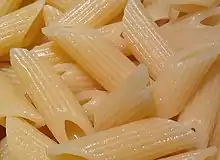Penne
Penne (Italian pronunciation: [ˈpenːe]) is an extruded type of pasta with cylinder-shaped pieces, their ends cut at a bias. Penne is the plural form of the Italian penna (meaning feather but pen as well), deriving from Latin penna (meaning "feather" or "quill"), and is a cognate of the English word pen. When this format was created, it was intended to imitate the then-ubiquitous fountain pen's steel nibs.[1]
 Penne lisce: the exterior of this pasta has a smooth surface | |
| Type | Pasta |
|---|---|
| Place of origin | Italy |
| Variations | Penne lisce, penne rigate, pennoni, mostaccioli |
Origins
Penne is one of the few pasta shapes with a certain date of birth: in 1865, Giovanni Battista Capurro, a pasta maker from San Martino d'Albaro (Genoa), obtained a patent for a diagonal cutting machine. His invention cut the fresh pasta into a pen shape without crushing it, in a size varying between 3 cm (1 in) mezze penne (half pens) and 5 cm (2 in) penne (pens).[1][2]
Description and variations

In Italy, penne are produced in two main variants: penne lisce (smooth) and penne rigate (furrowed), the latter having ridges on each penna. Pennoni ("big quills") is a wider version of penne.[3] A slightly larger version called mostaccioli (meaning "little mustache" in some Italian dialects) can also be found, which can also be either smooth or ridged in texture.[4]
Penne is traditionally cooked al dente and its shape makes it particularly adapted for sauces, such as pesto, marinara, or arrabbiata. The latter has been celebrated several times in Italian movies, notably in Marco Ferrari's La Grande Bouffe and Federico Fellini's Roma.[5]
In the Trenton, New Jersey, area, penne pasta is called "pencil points" due to its shape.[6]
See also
References
- "Penne? In origine erano con lo zafferano". Welovepasta.it. 28 June 2017. Retrieved 7 January 2019.
- "Mezze Penne Rigate n° 141 Integrali - Pasta De Cecco". Dececco.com. Retrieved 7 January 2019.
- "Pasta Shapes". Thenibble.com. Retrieved 2013-02-21.
- "Creamette - Our Products - Mostaccioli Rigati". Pasta-products-creamette.newworldpasta.com. Archived from the original on 2012-05-09. Retrieved 2013-02-21.
- Giorgioni, Livio (2002). La grande abbuffata : percorsi cinematografici fra trame e ricette. Pontiggia, Federico, 1978-, Ronconi, Marco, 1972-. Cantalupa (Torino): Effatà. p. 25. ISBN 9788874020225. OCLC 50875311.
- Richman, Steven M. (10 January 2014). Reconsidering Trenton: The Small City in the Post-Industrial Age. McFarland. p. 137. ISBN 9780786462230. Retrieved 7 January 2019 – via Google Books.
